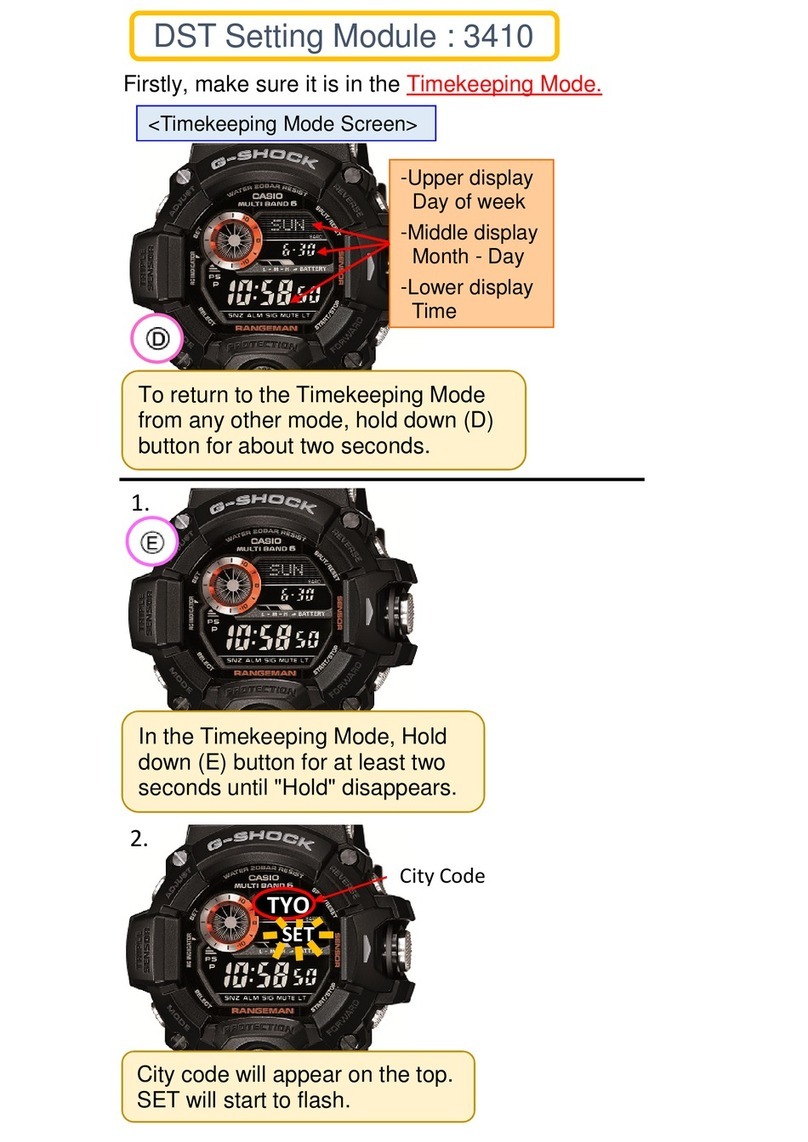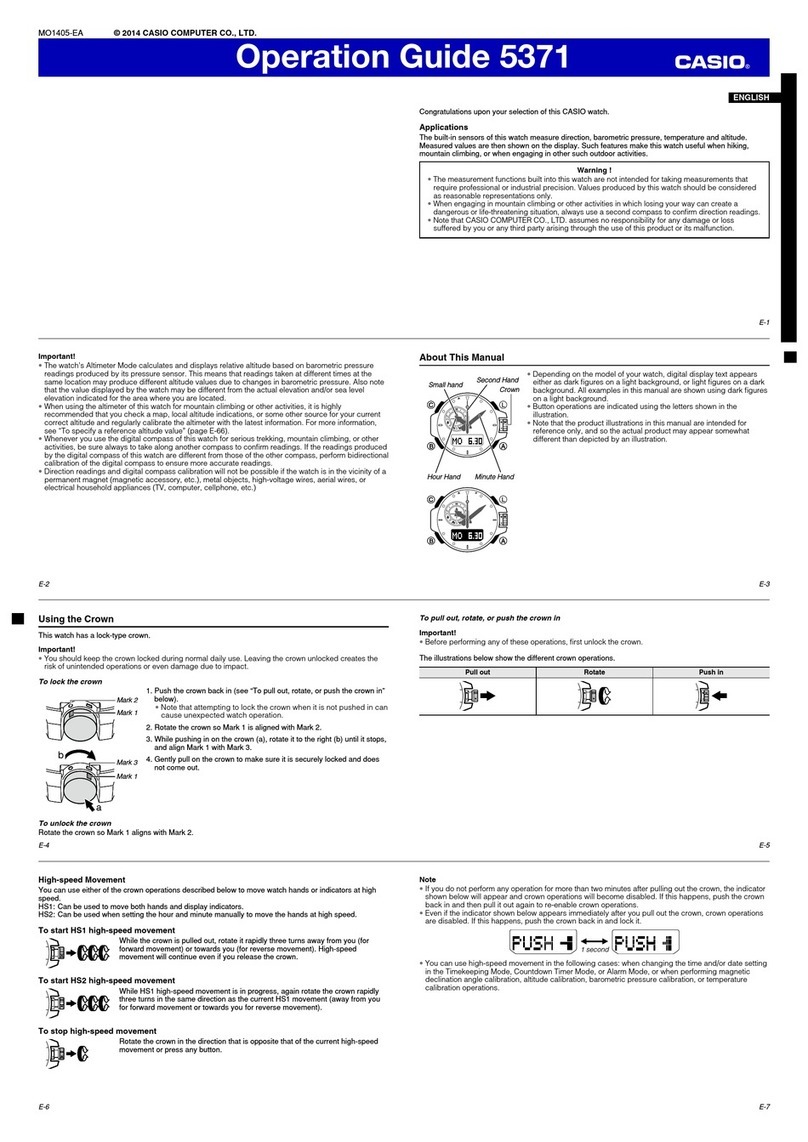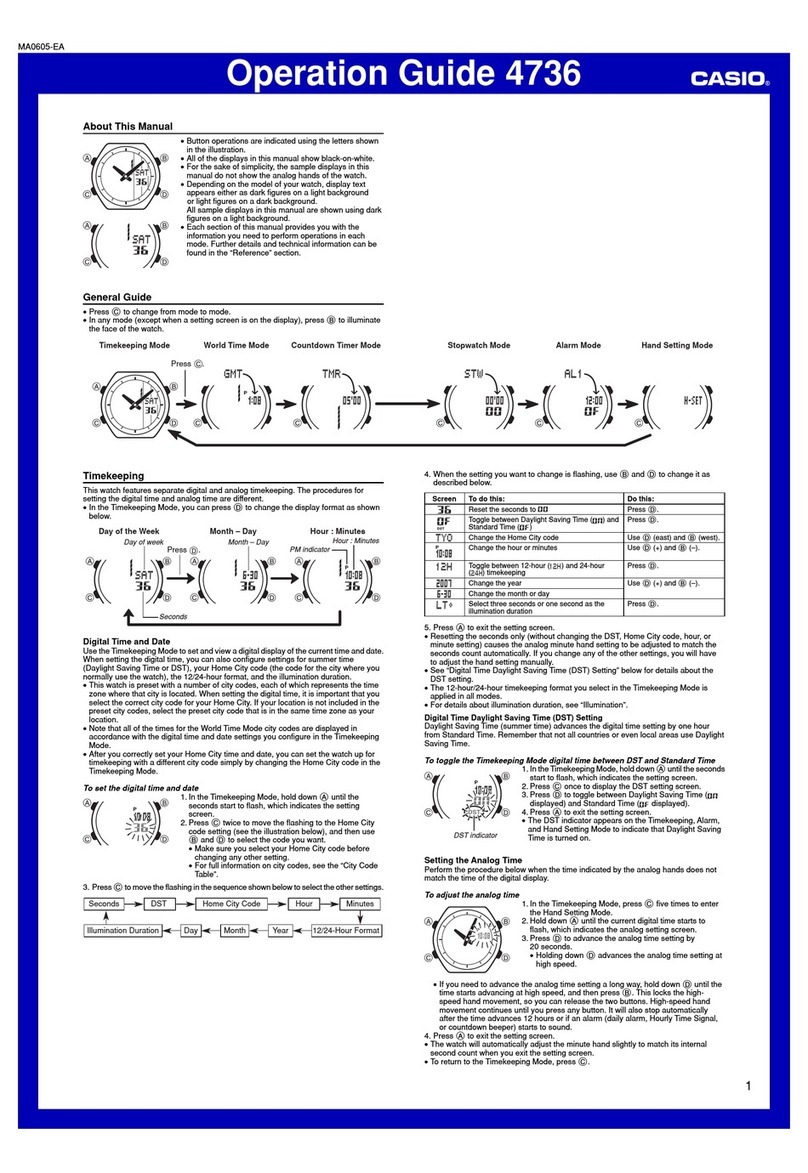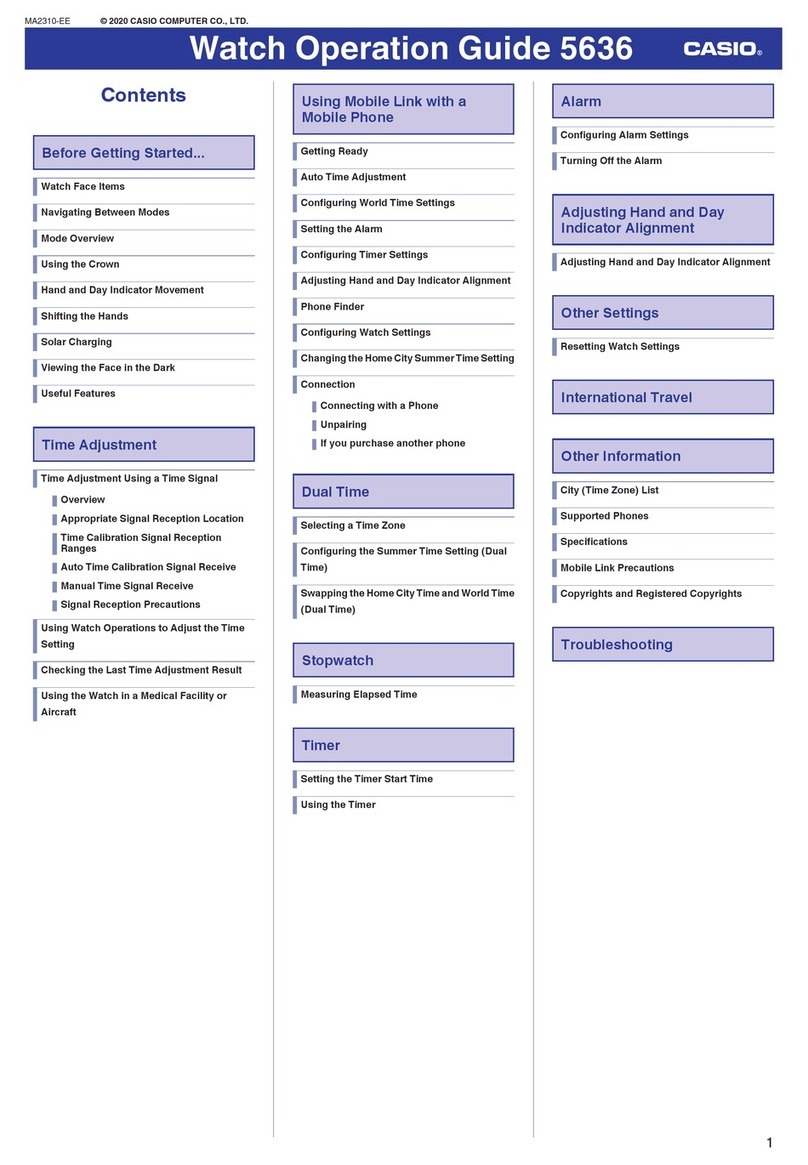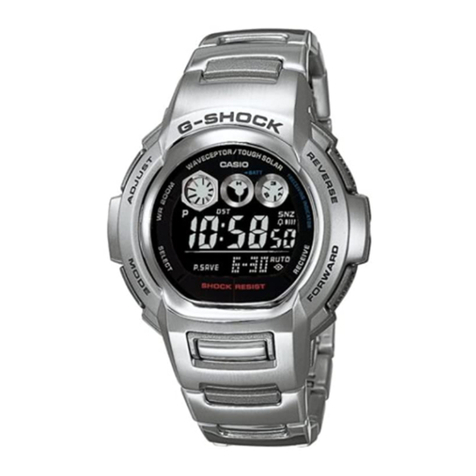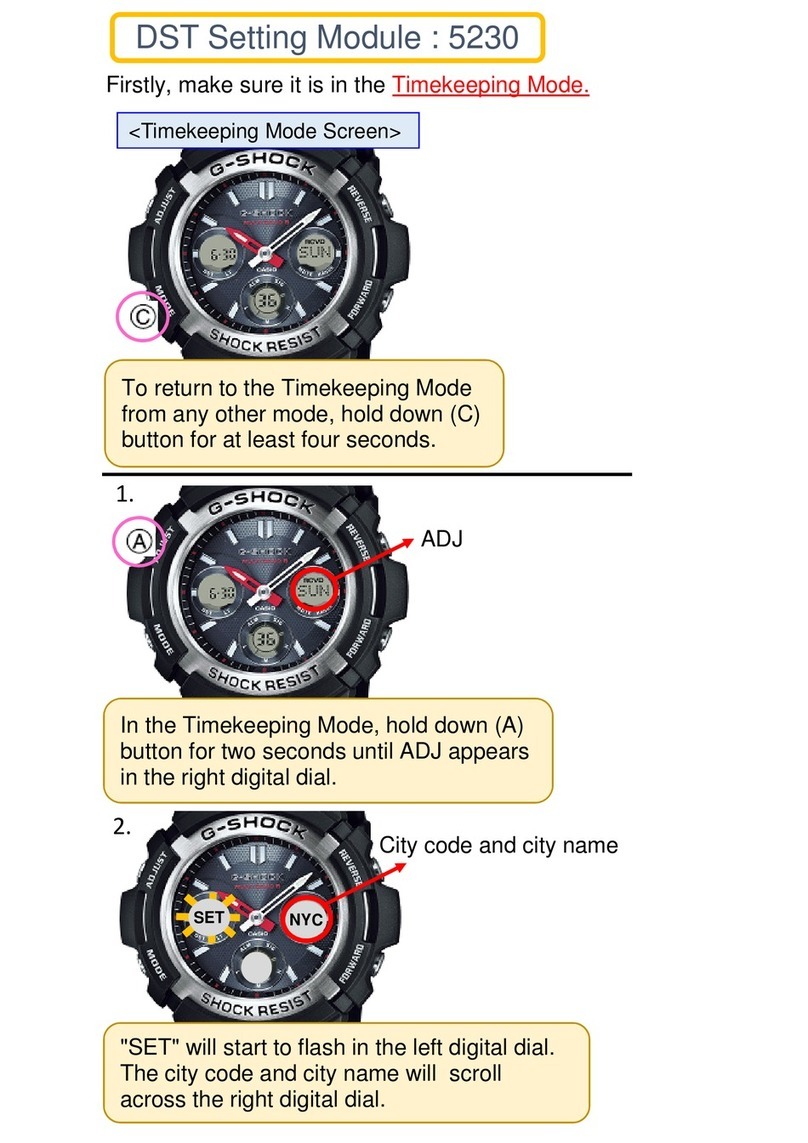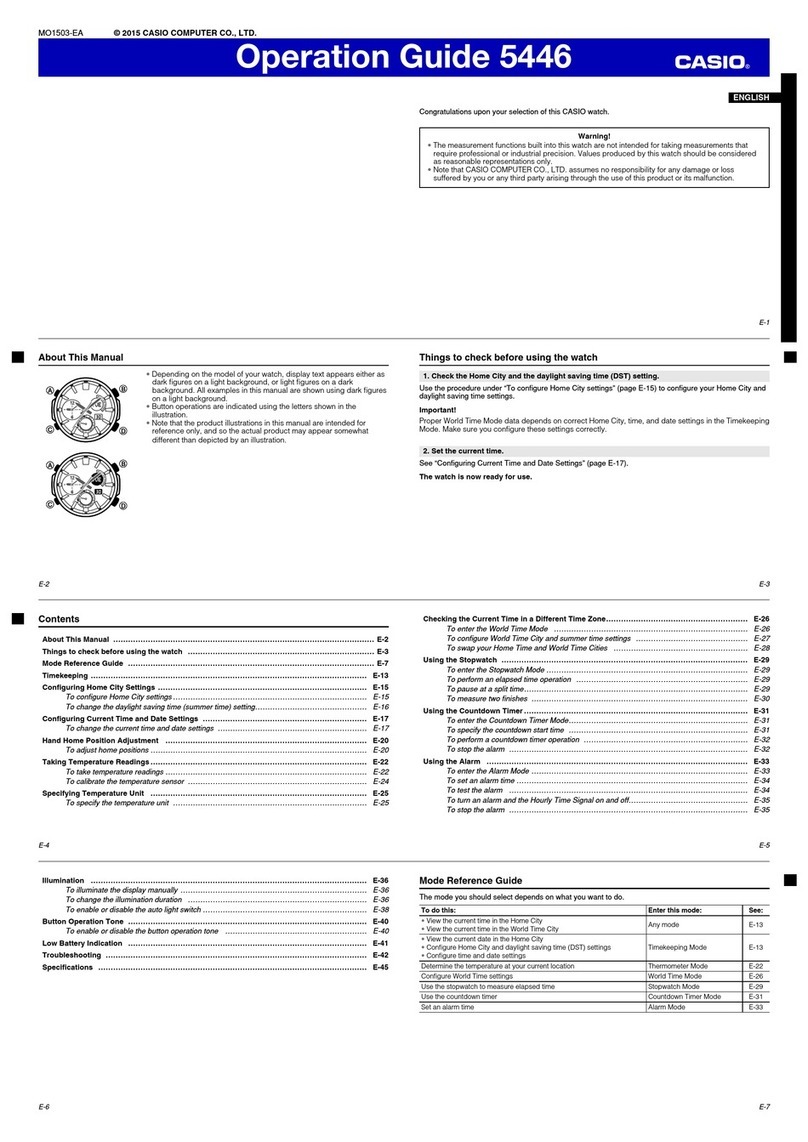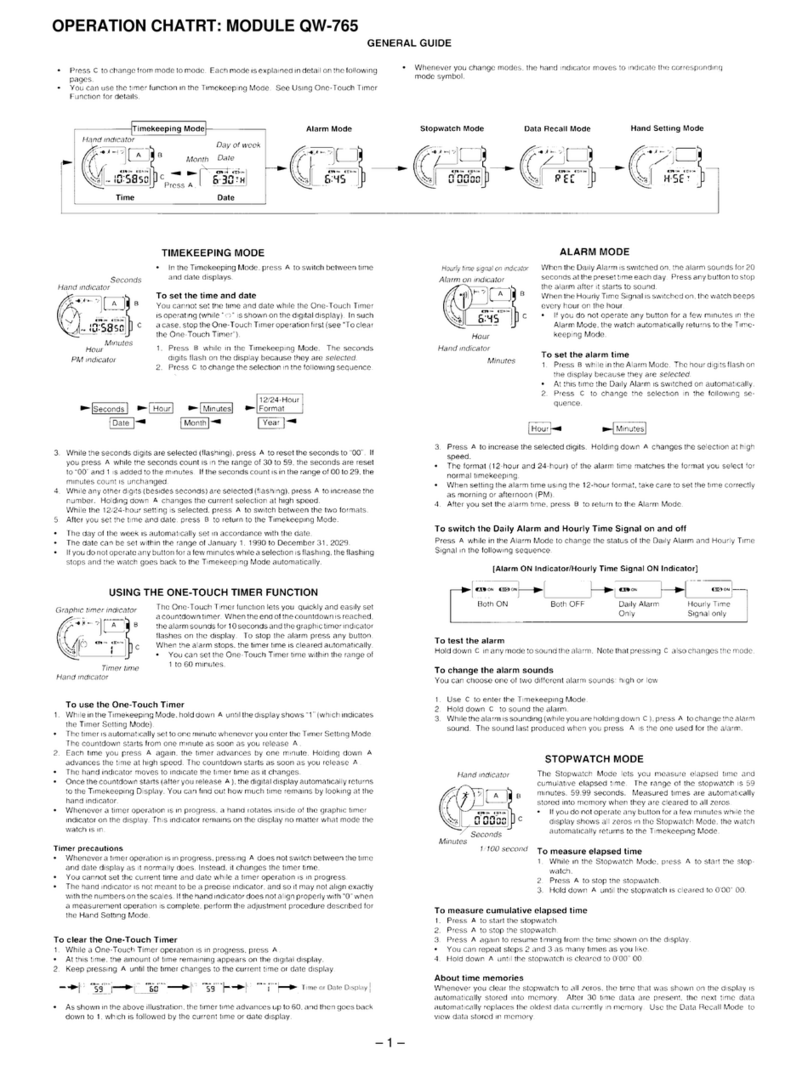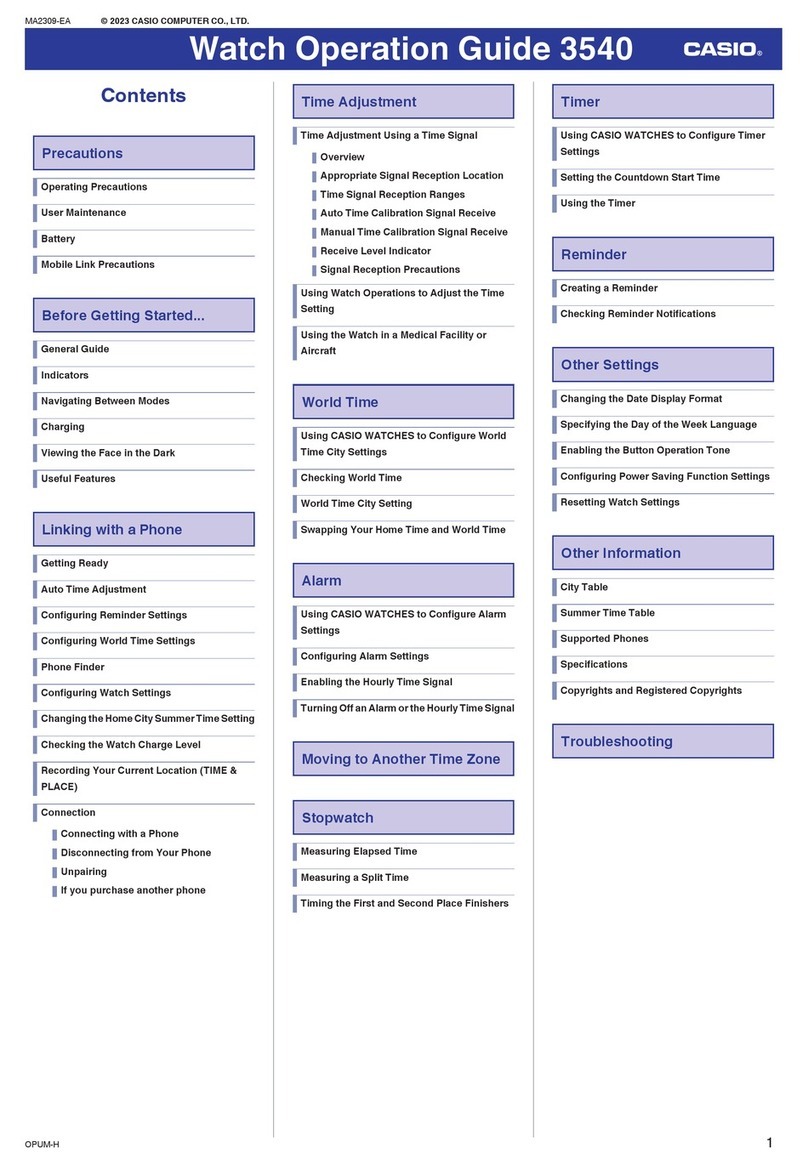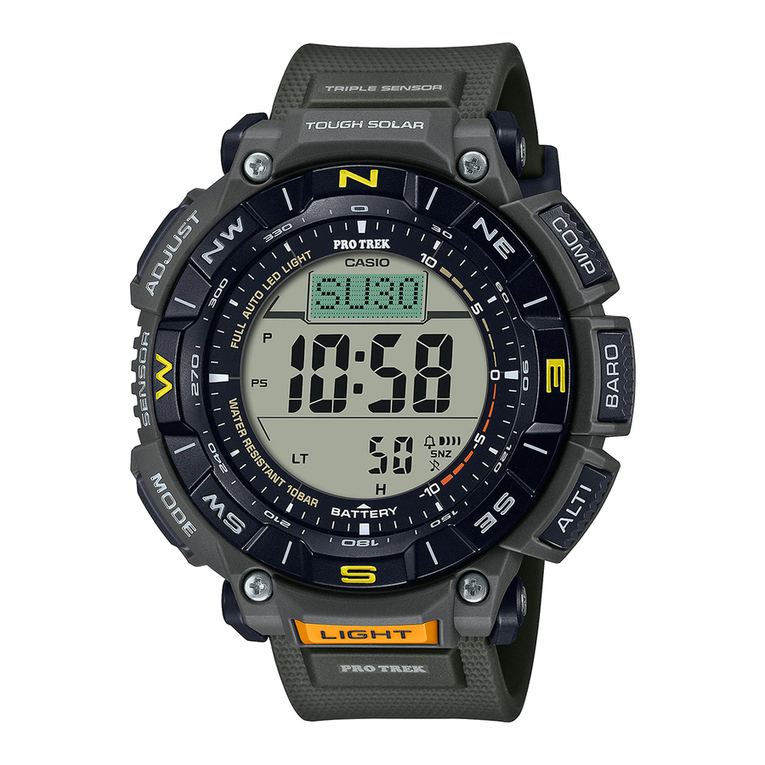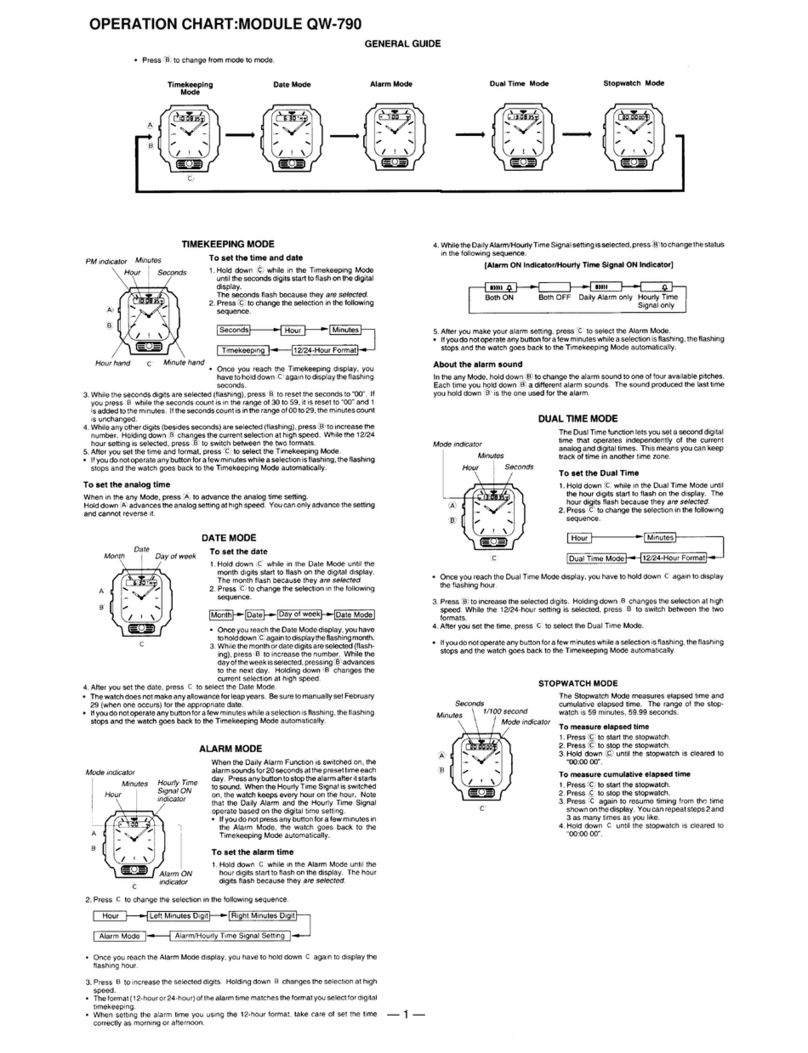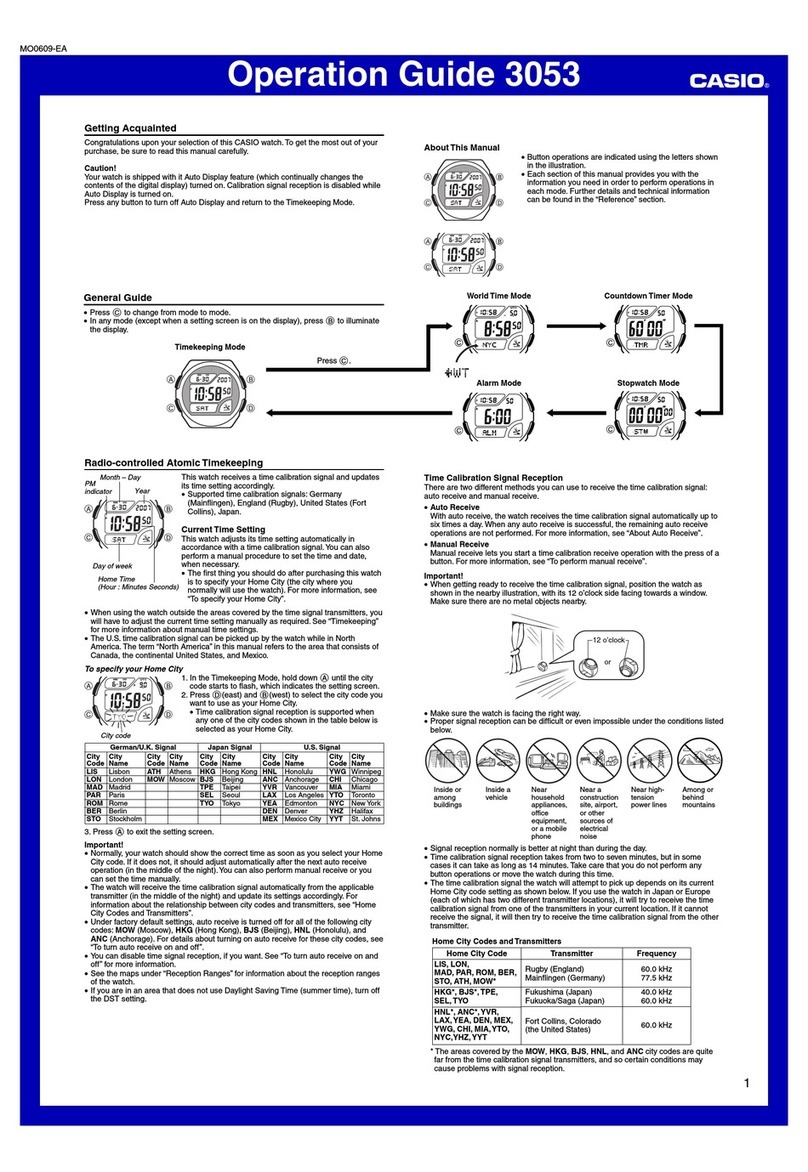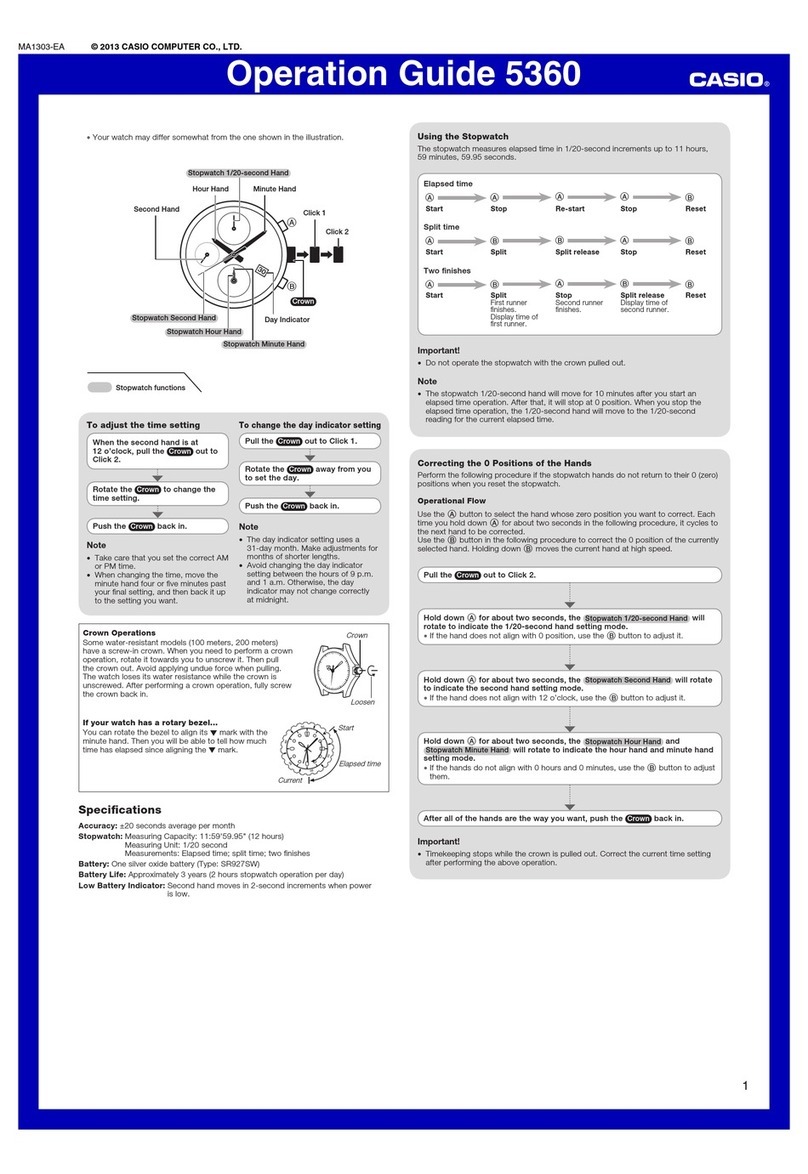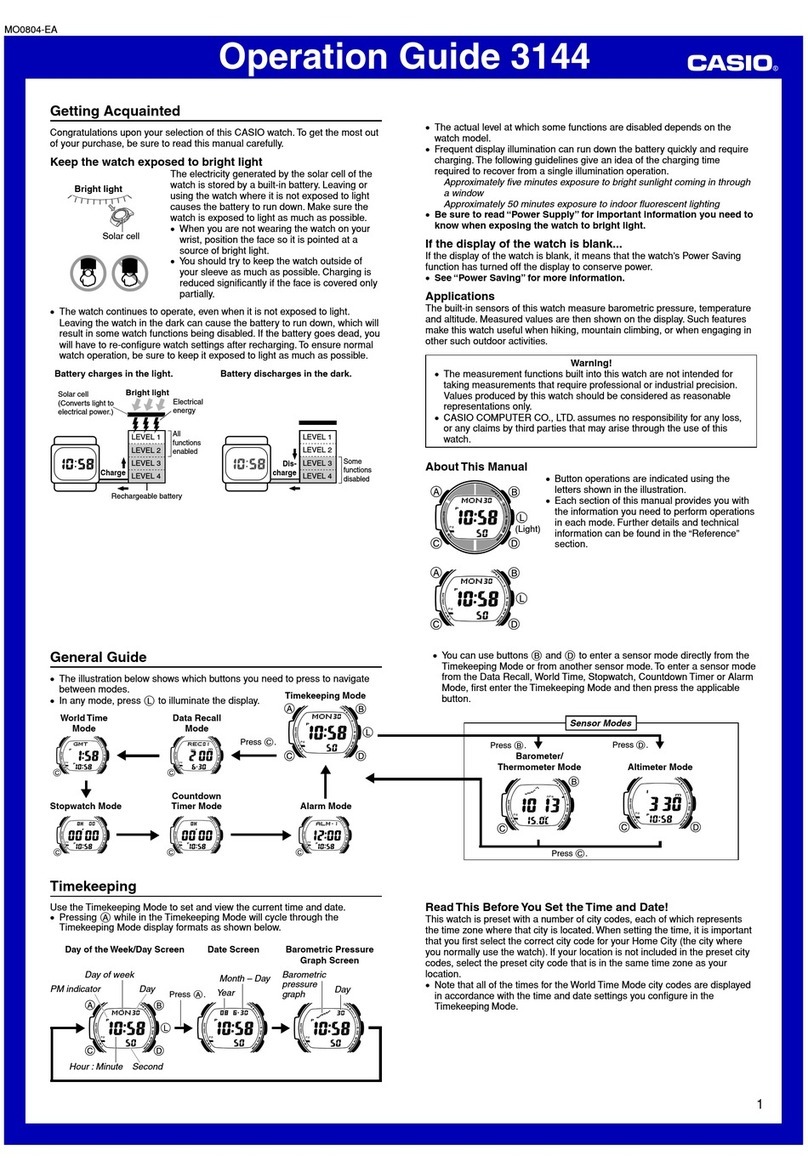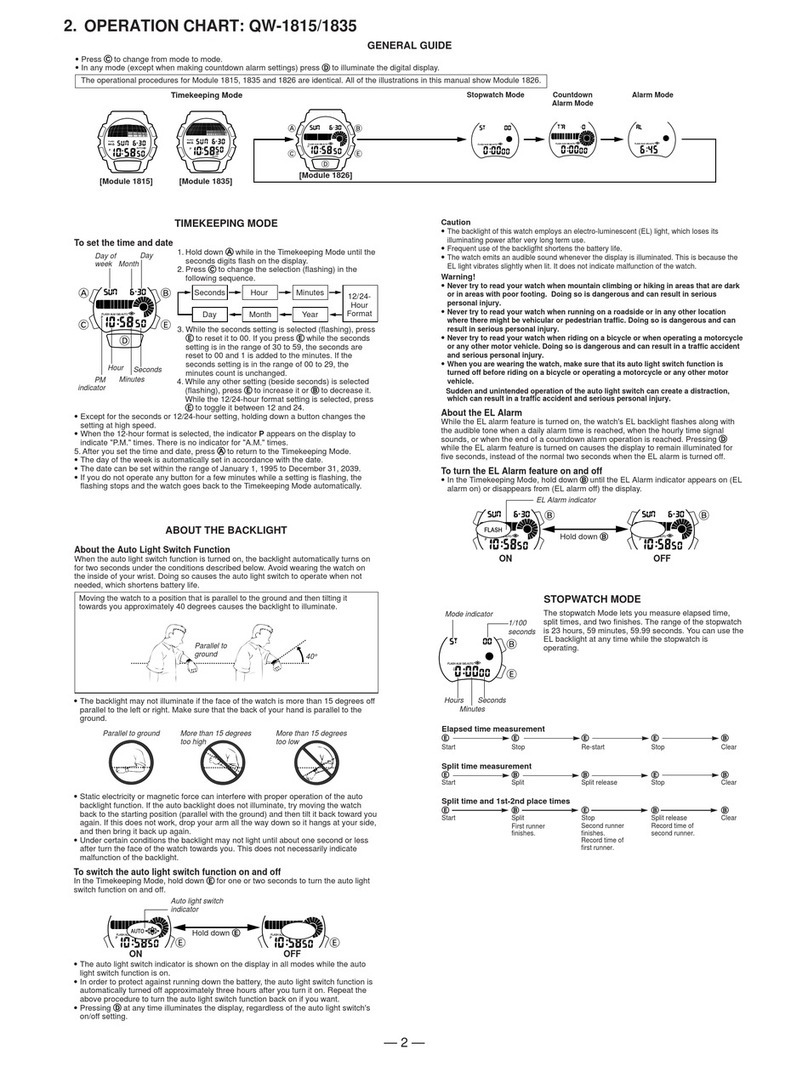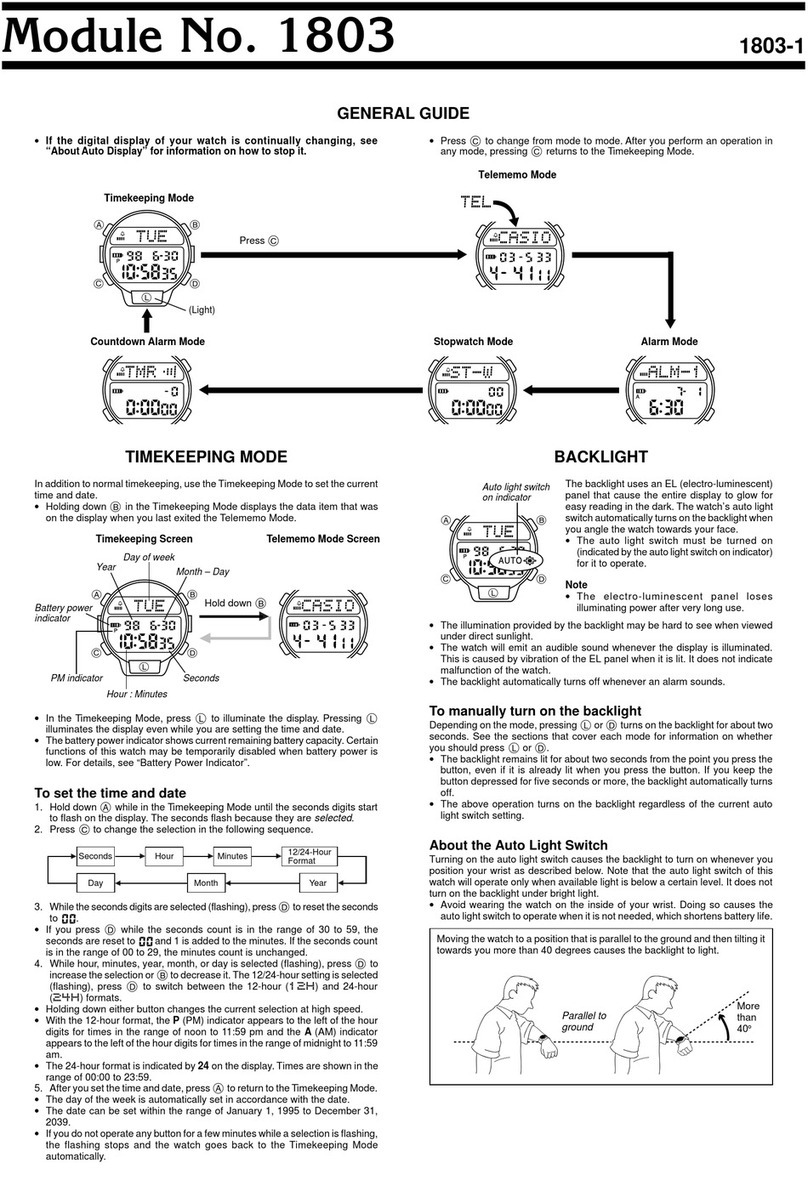
USER’S GUIDE 2630
2
Setting Target Values
In addition to configuring basic data, you can also use the
Basic Data Input Mode to specify targets in terms of time,
calories, distance, or number of steps. You can select any
one of the targets you set when performing an Exercise
Stopwatch Mode measurement operation. The watch will
perform an alert operation (beeper or vibration) to let you
know when you reach the selected target.
•The following shows the setting range and units for each
of the available target values.
•The Exercise Stopwatch elapsed time operation will stop automatically when the
time value reach 20 hours.
About the Pacer Signal
The pacer signal of this watch beeps in accordance with a pacer value (rate) set by
you. You can use the pacer signal to maintain a constant pace while walking.
•The pacer value you set specifies the number of steps per minute.
•
Turning on the pacer signal causes the watch to beep at the rate specified by the pacer value.
•The pacer signal will not sound if you have vibration alert turned on. If you want to
use the pacer signal, use the procedure “To switch between vibration alert and
beeper alert”to turn off vibration alert.
To set the pacer value
1. In the Exercise Stopwatch Mode, press E.
•This displays the current pacer value setting.
2. Start walking. As you walk, press the Ebutton each
time your foot hits the ground, for seven steps.
•
After the seventh press of
E
, the watch will calculate
an average pace and display the appropriate pacer value.
•Next, the pacer signal sounds in accordance with the
displayed value for about 15 seconds. You can stop the
pacer signal by pressing any button other than E.
•If the message ERR appears, it means that the
average pace calculated by the watch is outside the
range of 80 to 180 steps per minute.
•The ERR message will remain on the display for
about two seconds. After that, the current pacer signal
will appear as in step 1 of this procedure. Repeat step
2 to set a new pacer value.
3. To exit the pacer value screen, press any button
besides Eand L.
To sound the pacer signal
In the Exercise Stopwatch Mode, press Ato sound the pacer signal. The pacer signal
sounds for about 15 seconds, or until you stop it by pressing any button.
•The pacer signal will not sound if you have vibration alert turned on. If you want to
use the pacer signal, use the procedure “To switch between vibration alert and
beeper alert”to turn off vibration alert.
To perform an Exercise Stopwatch operation
1. In the Exercise Stopwatch Mode, press Bto start the
Exercise Stopwatch operation.
2. To stop the Exercise Stopwatch operation, press B.
•You can press Bagain to restart the Exercise
Stopwatch operation, if you want.
•You can use the Dbutton during an Exercise
Stopwatch operation to scroll through the data screens
shown below.
Targets
Time (MIN)
Calorie (Kcal)
Distance (KM)
(MI)
Number of Steps
Setting Range
0 to 500 minutes
0 to 2,000.00 kcal
0 to 50.00 km
0 to 50.0 mi
0 to 50,000
Setting Increment
10
50
0.50 km
1.0 mi
500
To set a target value
1. In the Basic Data Input Mode, press Dto scroll through the target screens as
shown below, and display the one whose setting you want to change.
Data type indicator (indicates target type)
•The Distance screen shown above, which indicates distance in kilometers (KM)
appears when you have centimeters selected as the stride length unit. If you have
inches selected as the stride length unit, the Distance screen indicates distance in
miles (MI).
•One of the target value screens always contains a target value, and all of the
other screens show “xx”in place of the target value. Setting a target value on a
screen that currently shows “xx”, causes the target value that is currently set on
another screen to change to “xx”.
•The initial default target value setting is “60”(minutes) on the Time (TIME)
screen.
2. Hold down Auntil the current input value starts to flash,
which indicates the setting screen.
•At this point, you could use Cto select other setting
screen settings in the sequence shown below.
Stride length
(CM or IN)
Weight
(KG or Lb)
Target Value
(time, calories, distance, number of steps)
•The stride length setting is selected when CM or IN is
shown for the measurement unit. The weight setting is
selected when KG or Lb is shown for the
measurement unit.
•For information about changing the stride length and
weight settings, see “Basic Data”.
3. While the target value is selected, use E(+) and B(–) to change it.
•You can have a target value set for only one target type (time, calories, distance, or
number of steps) at a time. Setting a target value on a screen that currently shows
“xx”, causes the target value that is currently set on another screen to change to
“xx”.
4. Press Ato exit the setting screen.
Exercise Stopwatch
If you input basic data and use the 15-second pacer
signal, the Exercise Stopwatch Mode will not only
measure the amount of time you spend walking, it will
also calculate the number of calories you burn and the
distance you cover, and even count the number of steps
you take. If you have a target value specified, the
Exercise Stopwatch will even perform an alert operation
to let you know when you reach your goal.
•All of the operations in this section are performed in the
Exercise Stopwatch Mode, which you enter by pressing
C.
Measurement unit
Elapsed time
(Hour : Minutes Seconds)
Timekeeping
Mode time
Data type
indicator
Target graph
Week graph
How the Exercise Stopwatch Works
Note that you must perform the following steps first before the Exercise Stopwatch
Mode will measure and calculate data, and store it in memory.
1. Set your basic data. See “Inputting Basic Data”.
2. Configure the pacer signal. See “About the Pacer Signal”.
Note
•In order to obtain accurate calorie and distance calculations, and step counts, you
must set accurate values for your weight and stride length, and keep your pace in
accordance with the 15-second pacer signal emitted by the watch.
•Exercise Stopwatch values are automatically stored in the watch’s memory and
cleared to zeros at midnight (12:00 a.m.) each day.
•If the time reaches midnight while an Exercise Stopwatch elapsed time operation is
in progress, the current elapsed time value at midnight is stored in watch memory.
The elapsed time operation continues from zero with the start of the new day.
•The following are the measurement and calculation ranges for each value.
Item
Time
Calorie
Distance (KM)
(MI)
Number of Steps
Range
0 to 20 hours
0 to 9,999.99 kcal
0 to 99.99 km
0 to 99.9 mi
0 to 999,999
Unit
1 second
0.01 kcal
0.01 km
0.1 mi
1
Screen Refresh Interval
1 second
10 seconds
1 pacer signal beep
1 pacer signal beep
Press in
time with
7 steps.
Pacer value
Counts number
of presses
(steps)
Exercise Stopwatch
elapsed time screen
Data type indicator
•Note that the Exercise Stopwatch operation continues, even if you exit the Exercise
Stopwatch Mode.
•If you perform an Exercise Stopwatch Mode operation while you have a target value
specified, the watch will perform an alert operation (beep or vibration) for about five
seconds to let you know when you reach your target.
To reset the Exercise Stopwatch to all zeros
1. Enter the Exercise Stopwatch Mode.
2. Make sure that Exercise Stopwatch operation is stopped.
3. Hold down Duntil the watch beeps.
•This causes CLR to flash on the display for about two seconds. After that, the
Exercise Stopwatch elapsed time display resets to zero, which completes the reset
operation.
Note
•Note that the Exercise Stopwatch data cleared using the above procedure is not
stored to watch memory.
Time Calories Number of StepsDistance
Time Calories Number of StepsDistance

